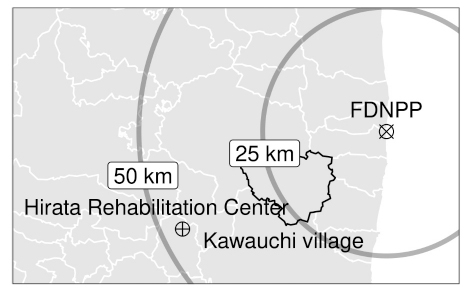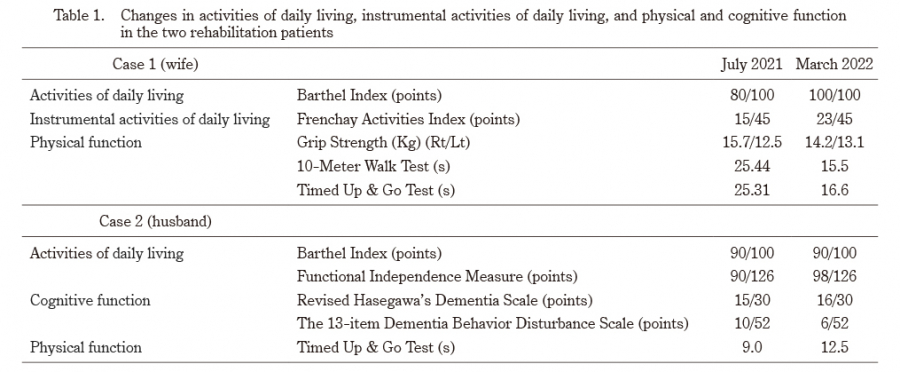1. Terayama K. Rehabilitation Challenges of Health Care for the Elderly in Japan. Asian J Occup Ther, 1(1):12-12, 2001.
2. Hotta F. Home rehabilitation. Japan Med Assoc J, 58(1-2):40-43, 2015.
3. Takahashi K, Tsukishima E. Changes in trends diseases requiring long-turm care in aging community. (in Japanese) Japanese Soc Public Heal, 68(3):195-203, 2021.
4. Bright T, Wallace S, Kuper H. A systematic review of access to rehabilitation for people with disabilities in low-and middle-income countries. Int J Environ Res Public Health, 15(10):1-34, 2018.
5. Strasser R. Rural health around the world: Challenges and solutions. Fam Pract, 20(4):457-463, 2003.
6. Song C, Wang Y, Yang X, et al. Spatial and temporal impacts of socioeconomic and environmental factors on healthcare resources:A county-level bayesian local spatiotemporal regression modeling study of hospital beds in Southwest China. Int J Environ Res Public Health, 17(16):1-23, 2020.
7. Matsunaga H, Orita M, Liu M, Kashiwazaki Y, Taira Y, Takamura N. Evaluation of Residents’ Timing of Return to or New Settlement in Kawauchi Village, at 10 Years after the Fukushima Daiichi Nuclear Power Plant Accident. Int J Environ Res Public Health, 19(1):543, 2022.
8. Ishikawa K, Kanazawa Y, Morimoto S, Takahashi T. Depopulation With Rapid Aging In Minamisoma City After the Fukushima Daiichi Nuclear Power Plant Accident. J Am Geriatr Soc, 73(3):160-162, 2012.
9. Nishikawa Y, Tsubokura M, Yamazaki S. Healthcare delivery to a repopulated village after the fukushima nuclear disaster:A case of kawauchi village, Fukushima, Japan. Japan Med Assoc J 59(4):159-161, 2016.
10. Sawano T, Nishikawa Y, Ozaki A, et al. Premature death associated with long-term evacuation among a vulnerable population after the Fukushima nuclear disaster:A case report. Medicine (Baltimore), 98(27):e16162, 2019.
11. Orui M, Nakayama C, Moriyama N, et al. Current psychological distress, post-traumatic stress, and radiation health anxiety remain high for those who have rebuilt permanent homes following the Fukushima nuclear disaster. Int J Environ Res Public Health, 17(24):1-14, 2020.
12. Nishikawa Y, Ozawa Y, Tsubokura M, et al. Long-term vulnerability of access to hemodialysis facilities in repopulated areas after the Fukushima Nuclear Disaster:A case report. Oxford Med Case Reports, 2018(7):228-230, 2018.
13. Nishikawa Y, Tsubokura M, Takahashi Y, et al. Change of access to emergency care in a repopulated village after the 2011 Fukushima nuclear disaster:a retrospective observational study. BMJ Open, 9(2):e023836, 2019.
14. Kobashi Y, Morita T, Ozaki A, et al. Long-term Care Utilization Discrepancy Among the Elderly in Former Evacuation Areas, Fukushima. Disaster Med Public Health Prep, 16(3):892-894, 2022.
15. Miyagawa A, Tanigawa K. Health and medical issues in the area affected by fukushima daiichi nuclear power plant accident. Int J Environ Res Public Health, 19(1):144, 2022.
16. Saito Y, Sato K, Itagaki T, et al. Home - visit rehabilitation in a repopulated village after the Fukushima nuclear disaster. Fukushima J Med Sci, 68(2):71-77, 2022.
17. Kobashi Y, Nishikawa Y, Morita T, Omata F, Ito N, Tsubokura M. Demographic Change of the Kawauchi Special Nursing Home Occupants in a Former Evacuation Area After the Nuclear Power Plant Accident:A Retrospective Observational Study. Disaster Med Public Health Prep, 17:e204, 2022.
18. Cuccurullo SJ, Fleming TK, Kostis WJ, et al. Impact of a Stroke Recovery Program Integrating Modified Cardiac Rehabilitation on All-Cause Mortality, Cardiovascular Performance and Functional Performance. Am J Phys Med Rehabil. 98(11):953-963, 2019.
19. Machida A. Estimation of the reliability and validity of the short version of the 28-item Dementia Behavior (In Japa nese). Nippon Ronen Igakkai Zasshi, 49(4):463-467, 2012.
20. Jones CA, Voaklander DC, Johnston WC, Suarez-Almazor ME. The effect of age on pain, function, and quality of life after total hip and knee arthroplasty. Arch Intern Med, 161(3):454-460, 2001.
21. Moriyama N, Nishikawa Y, Hoshi W, et al. Association of instrumental activities of daily living, physical function and mental health among older returnees after the fukushima daiichi nuclear power station accident. Int J Environ Res Public Health, 18(21), 2021. doi:10.3390/ijerph182111639
22. Heine J, Koch S, Goldie P. Patients’ experiences of readiness for discharge following a total hip replacement. Aust J Physiother, 50(4):227-233, 2004.
23. Nishikawa Y, Niimura H, Ozaki A, et al. Successful institutional care for behavioral and psychological symptoms of dementia in a repopulated area after the 2011 Fukushima disaster:A case report. Clin Case Reports, 6(11):2266-2270, 2018.
24. Zhang P. Characteristics of Community-Dwelling Senior Couples on the Independent Life (in Japanese). J Cult Nurs Stud, 11(1):59-66, 2019.
25. Kobayashi S, Shiratani Y, Tadaka E, Ito E, Okouchi A, Arimoto A. Experiences of Spousal Caregivers of Persons with Dementia in Elderly Couple Households (in Japanese). Japan Acad Community Heal Nursing, 21(1):32-39, 2018.
26. Nagai S, Takahashi R, Hirano Y, Okamura T, Takegaki K. Focus on mindset of frail elderly in elderly couples who are continuing home Care (in Japanese). J Kochi Women’s Univ Acad Nursing, 33(1):122-128, 2008.
27. Michelet M, Selbaek G, Strand BH, et al. Associations between unmet needs for daytime activities and company and scores on the Neuropsychiatric Inventory-Questionnaire in people with dementia: a longitudinal study. Aging Ment Health, 26(4):725-734, 2022.
28. Takizawa Y, Sugiura M, Shirai Y, Goto K, Keiichiro G, Hayakawa T. Provision of transportation services by medical institutions in mid-mountainous areas. (in Japanese). Journal Japanese Assoc Rural Med, 62(5):745-749, 2014.
29. Hatoma A. Exploring issues related to the transfer of elderly persons during day care services and home help services (in Japanese). Bull Kochi Prefect Univ Sch Soc Welfare, ed., 64(1):51-59, 2014.
30. Mori H, Nishimura H, Taniguchi M. Intention f use when plural mobility services are available in depopulation region (in Japanese). Civil Eng Soc Proc D3, 72(5):I_1145-I_1154, 2016.
31. Nishikawa Y, Fukuda Y, Tsubokura M, Kato S, Nomura S, Saito Y. Managing Type 2 Diabetes Mellitus through Periodical Hospital Visits in the Aftermath of the Great East Japan Earthquake Disaster:A Retrospective Case Series. PLoS One, 10(5):e0125632, 2015.


